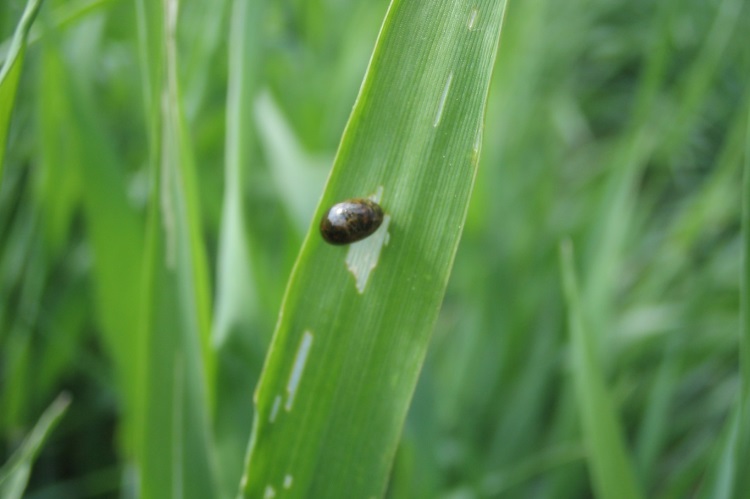All Cereals – October 2020
1 October 2020Pests
The numbers of aphids flying into crops will be dropping with the change to cooler weather. There is still a risk of cereal aphids picking up barley yellow dwarf virus (BYDV) from infected plants and spreading the virus to cereals being sown this autumn.
Due to the loss of the neonicotinoid seed treatments there is a reliance on the use of pyrethroid insecticides for the management of aphids and the transmission of BYDV into cereals. Grain aphids in Scotland are demonstrating resistance to the pyrethroid aphicides. As a result, reliance on a pyrethroid aphicide spray is a risk as grain aphids may not be adequately controlled, elevating the risk of BYDV.
The most effective way of managing the ‘green-bridge’ of aphids on volunteers and stubble and preventing them walking onto emerging crops is to kill off any aphid host plants before sowing. Ideally stubble from the previous crop should be desiccated with a herbicide, ploughed in 7-10 days later and left for another 2 weeks before sowing the next crop. This will ensure that any aphid host plants will be dead and any aphids on them will have starved to death. Alternatively, stubble can be ploughed in and sowing delayed for 4 weeks to allow enough time for plants to die along with the aphids.
Both of these approaches will reduce the threat from walking aphids by killing off their host plants that could keep the aphids (and BYDV) ticking over. Aphids are quite resilient and can work their way up to the soil surface after ploughing, so killing off the plants is essential so that they won’t have anything to feed on underground. However, for aphids flying into the crop at crop emergence aphicide sprays are the only option.
A combined approach of tackling the ‘green-bridge’ for the walking aphids and using an aphicide to target the flying aphids is the only option available to reduce the risk of BYDV. Reducing the availability of BYDV reservoirs in cereals and volunteers/stubble, and in aphids overwintering on winter cereals will reduce the risk to spring cereals, where a pyrethroid aphicide spray at early crop emergence is again the only option currently available, and this may not take care of the grain aphid due to widespread resistance.
Because of the resistance issue in the grain aphid, try to avoid the use of pyrethroid aphicides on cereals for BYDV unless absolutely necessary – aphid colonies on the leaves in the autumn rather than individual aphids is the trigger for an aphicide treatment.
Other pests
To reduce the threat from frit fly and leatherjackets, ploughing in grass or grassy stubble and leaving for a month is the best approach to prevent carry over of these pests into the next cereal crop, including the spring crop. This is particularly relevant now that chlorpyrifos is no longer available as an insecticide treatment for these pests.
To determine whether there is a risk from these pests arrange for soil sampling, but make sure it is carried out before ploughing in of the grass. This is recommended if there is a history of frit fly or leatherjackets on the farm.
Opomyza, also known as the yellow cereal fly is occasionally an issue. Earlier sown wheat crops (September) are most at risk as the fly needs to have a brairded crop to lay its eggs on. However, we have in the past seen damage on wheat crops sown in October, which suggests that egg laying can continue into November depending on the season. They can also attack barley and rye.
The threat from wheat bulb fly is discussed in the Winter wheat article.
Weeds
Stubble treatment with glyphosate in earlier harvested fields to control couch grass and other weeds could be effective this year if it stays reasonably mild and the couch is actively growing. It needs to have 4-5 well developed leaves, each leaf with 10-15 cm growth. Glyphosate products vary in how rain fast they are – generally a minimum of 1 hour dry weather after spraying. Glyphosate is water soluble and needs time to be absorbed into the plant.
Perennial broad-leaved weeds and volunteer potatoes can also be treated at this time of year, provided they are actively growing. Use a high dose for volunteer potatoes and make sure there is adequate leaf to absorb the chemical.
The choice is between a single active ingredient glyphosate product, and the two active ingredient glyphosate + 2,4-D product.
A glyphosate only product is very effective on grass weeds but can be slower acting on broad-leaved weeds. Check the label for the appropriate dose – a higher dose is needed for perennials and volunteer potatoes than for annual grass weeds.
The 2,4-D and glyphosate product is worth trying if there are perennial broad-leaved weeds or volunteer potatoes present. Check the label for the appropriate dose. But remember that the 2,4-D has some residual activity in the soil so check the label for re-planting intervals – 5 days if the field is going into cereals, 28 days if it is going into winter beans.
Sign up to the FAS newsletter
Receive updates on news, events and publications from Scotland’s Farm Advisory Service

